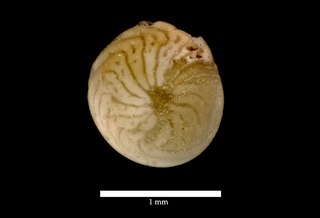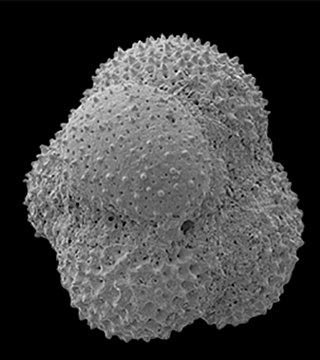Related Research Articles

The Globigerinina is a suborder of foraminiferans that are found as marine plankton. They produce hyaline calcareous tests, and are known as fossils from the Jurassic period onwards. The group has included more than 100 genera and over 400 species, of which about 30 species are extant. One of the most important genera is Globigerina; vast areas of the ocean floor are covered with Globigerina ooze, dominated by the shells of planktonic forms.

Globigerina is a genus of planktonic Foraminifera, in the order of Rotaliida. It has populated the world's oceans since the Middle Jurassic.

The Rotaliida are an order of Foraminifera, characterized by multilocular tests (shells) composed of bilamellar perforate hyaline lamellar calcite that may be optically radial or granular.
Carterina is a genus in the family Trochamminidae, composing its own subfamily Carterininae. The genus is described from specimens gathered during the Challenger expedition's circumnavigation of the Earth from 1872-1876.

The Asterigerinacea is a superfamily of Foraminifera included in the order Rotaliida, proposed by Loeblich and Tappan in 1988.
Discorbacea, Discorboidea in recent taxonomies, is a superfamily of foraminifera,, with a range extending from the Middle Triassic to the present, characterized by chambers arranged in a low trochspiral; an umbilical or interiomarginal aperture, with or without supplementary apertures; and a wall structure that is optically radial.
Abathomphalus is a genus of foraminifera included in the Globotruncanid family.
The Spirillinida are an order of foraminifera in which the test, or shell, primitively consists of an enrolled open tube, coming after the proloculus, wound planospirally or conically, commonly composed of an optically single crystal of calcite. The aperture is a simple opening at the end of the tube. Advanced forms with more than one chamber may consist of a few crystals, or rarely, a mosaic of crystals of calcite.
Acervulinacea is a superfamily in the Foraminifera order Rotaliida. The Acervulinacea may be free, or able to move about, or their tests may be attached to some substrate. The early growth stage is spiral, followed by irregular chambers that form an irregular mass, disc, or branching structure. The test wall is of hyaline (glassy) optically radial calcite and is coarsely perforate. Apertures are present only as mural pores.

Globigerinoidea is a superfamily of free-living, calcareous, planktonic foraminiferal protists that have lived in the open ocean since the Eocene. It is part of the suborder Globigerinina.
Involutinida is an order of foraminifera included in the Spirillinata found in the fossil record from the early Permian to early Late Cretaceous (Cenomanian).

Cibicides is a genus of cosmopolitan benthic foraminifera known from at least as far back as the Paleocene that extends down to the present.
Discorbis is a genus of benthic Foraminifera, that made its first appearance during the Eocene. Its present distribution is cosmopolitan.
The Cassidulinacea is a superfamily of benthic amoeboid foraminifera in the order Rotaliida that has been extant from the Paleocene down to the present. Tests are composed of secreted, optically radial or granular, perforate calcite with chambers biserially coiled at least in the early part, Apertures are usually an interiomarginal slit, but may become terminal and may have secondary features.

The Planorbulinacea are a superfamily of rotalliid foraminifera that has been extant since the Early Cretaceous (Berriasian), characterized by trochospiral tests, at least in early stage but which later may become uncoiled. The test wall is of perforate hyaline calcite, commonly optically radial in structure, with crystallographic c-axes perpendicular to the surface. The apertural face may be imperforate; the aperture interiomarginal and extraumbilical-umbilical to nearly equatorial in coiled forms, subterminal in uncoiled forms.
The Globoroatioidea constitutes a superfamily of Cenozoic plantonic foraminifera. It is part of the suborder Globigerinina. Globoroatioidea have trochospiral tests with rounded to carinate peripheries, the walls of which are of finely lamellar, perforate, of optically radial calcite, with an inner organic lining. The surface of these tests is smooth, lacking spines, but may be covered with pustules or pitted, and may have one or more large pores at the center. There is a single primary aperture that may be bordered by an imperforate lip, as well as possible supplementary apertures.
Sigmoilina is a miliolid genus, referring to the foraminiferal order Miliolida, characterized by an assymmetricall biconvex test formed by strongly overlapping chambers, one-half coil in length, that form a sigmoid (S-shaped) curve in cross section. The strongly overlapping chambers obliterate earlier ones from view resulting in the compressed biloculine appearance, differing from the squat, depressed biloculine form of Pyrgo and Biloculina. The test, as for all Miliolida, is porcelaneous and imperphorate, the terminal aperture, with tooth, the only point of egress and ingress for the animal.

Rotaliana is a subclass of benthic Foraminifera with multichambered tests of perforate hyaline calcite. Tests may be planospiral, low or high trochospiral, or serial. Interiors may be complex with secondary chambers and interconnecting canal systems. Rotaliana are separate from the planktonic Globigerinana although both have tests of similar composition. The Textulariana, which contains forms that are rather similar, differs in be agglutinated.

Acarinina is an extinct genus of foraminifera belonging to the family Truncorotaloididae of the superfamily Globorotalioidea and the suborder Globigerinina. Its fossil range is from the upper Paleocene to the middle Eocene. Its type species is Acarinina nitida.
Chilostomelloidea is a superfamily of foraminifera in the order Rotaliida. They are found in sediments of Early Cretaceous (Barremian) to the present.
References
- ↑ s.O.Globigerinina World Foraminiferal Database
- ↑ B.K. Sen Gupta 2002 Modern Foraminifera
- ↑ A.R. Loeblich jr & H Tappan 1964. Treatise on Invertebrate Paleontology Part C Protista 2